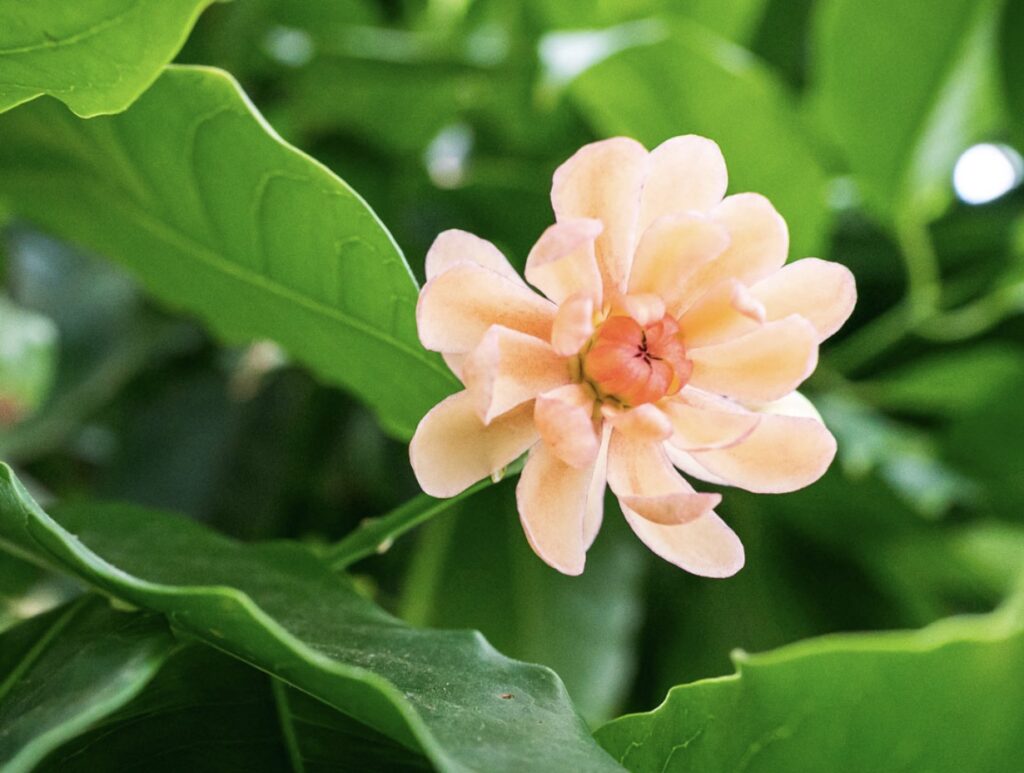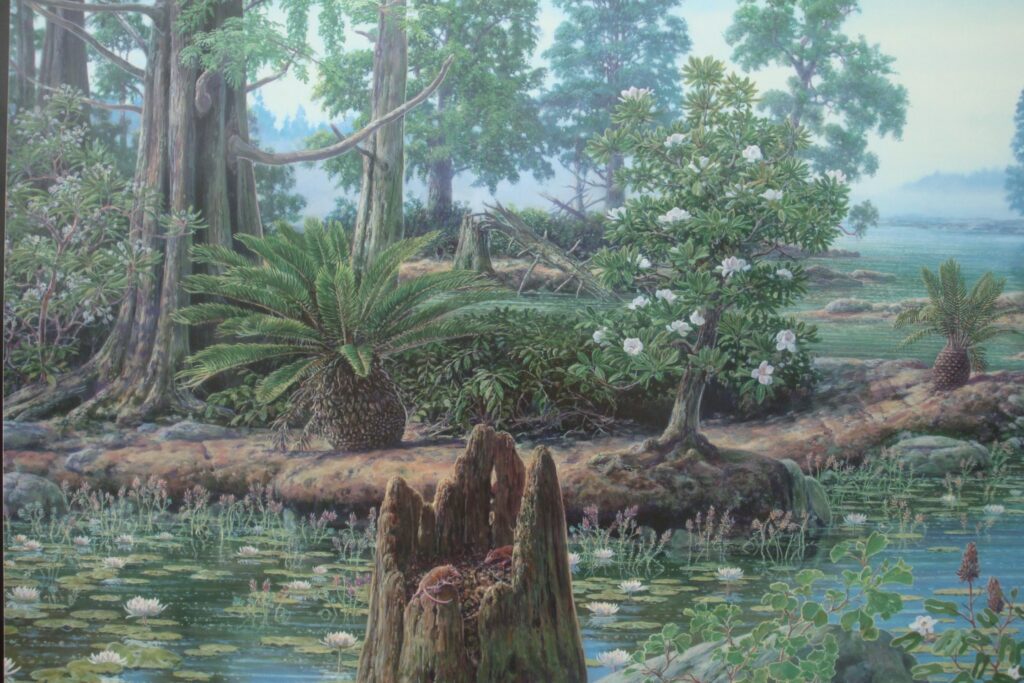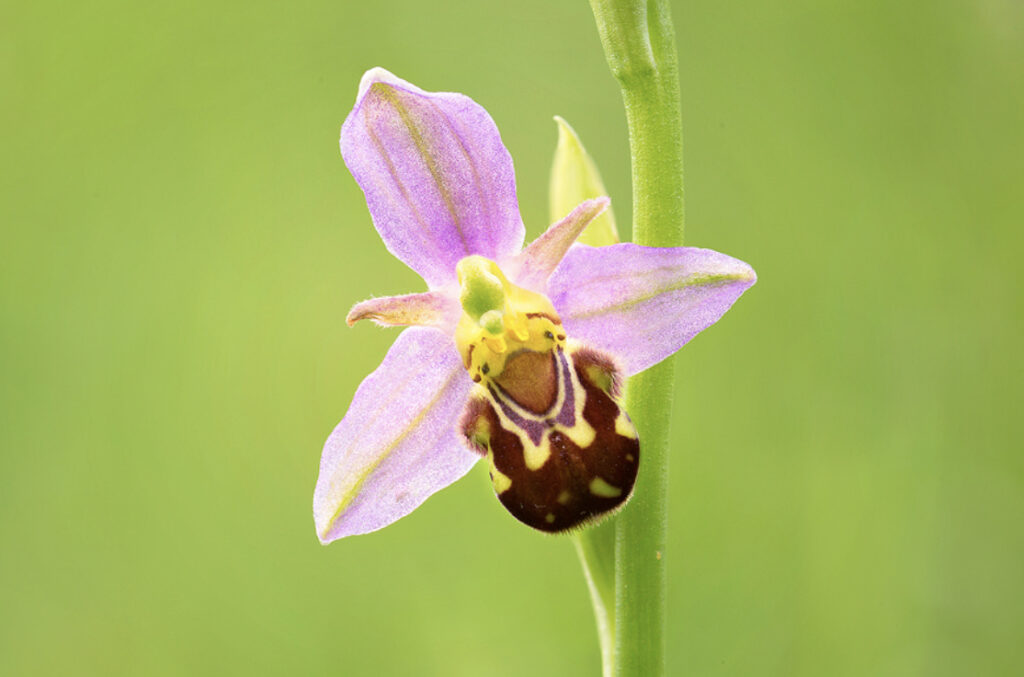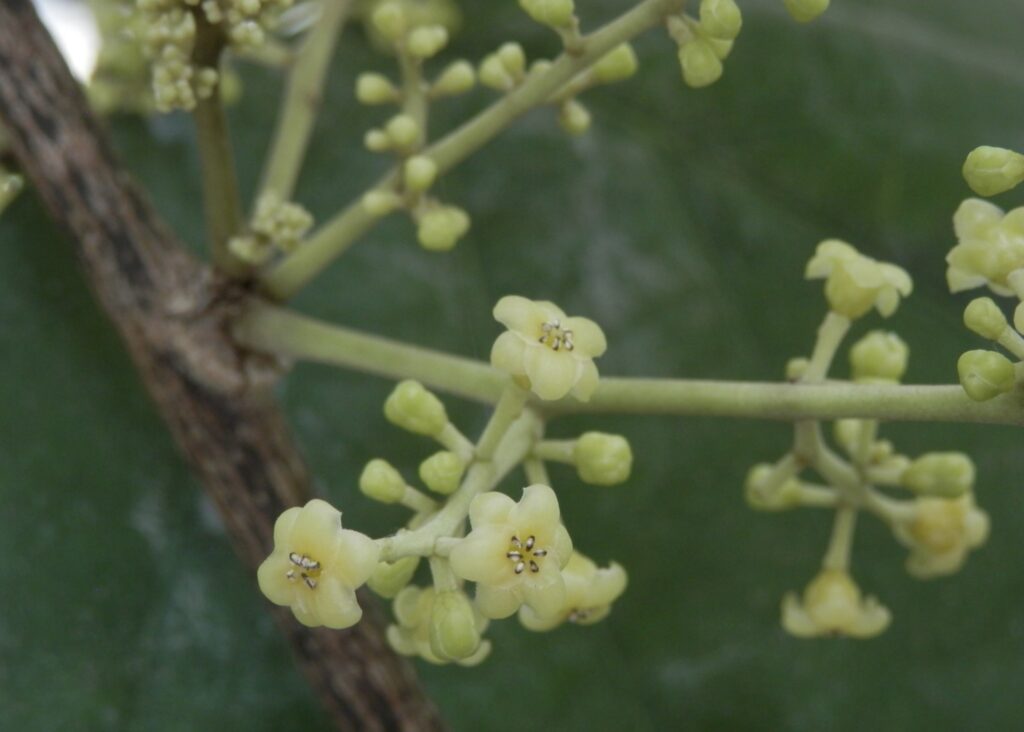
by Quantum Botanicals Advanced student, Erin Shaw
Known as Darwin’s “abominable mystery” and distinguished by their unique, usually obvious, rather beautiful and intriguing reproductive organs – their flower- angiosperms dominate the kingdom plantae. Or to put it simply, flowers rule the plant world. A huge ca. 90% of the plants we experience on land are angiosperms (Sauquet, et al. 2017) so it is difficult to imagine our world without the colour and diversity of these flowering plants whose history and beginning is filled with mystery and intrigue. With an estimated nearly 400,000 extant species (Soltis, et al. 2019), angiosperms seem to have had a rather sudden genesis followed by a super successful period of diversification, taking over the plant kingdom and quickly becoming the most crucial element in biodiversities all over the planet. The question that has driven many scientists from evolutionary biologists to plant geneticists to palaeobotanists, is how, when and why that very first flower appeared? There obviously were environmental, genetic and / or morphological changes that stimulated the beginning of the plant kingdoms ruler’s, but what the conditions were exactly is still a mystery.

Around 140 million years ago (MYA), during the early Cretaceous period, dinosaurs were roaming the planet, insects were crawling and flying, fish were swimming, plants were steadily growing and angiosperms were just beginning their dominance of the biosphere. Fossil records show that there is an abundance of angiosperm diversification at this time, (Magallón, et al., 2018, and Magallón, et al., 2015) but before this, evidence of their existence has not been uncovered. The origin of flowers is still today only estimated, assumed or calculated using mathematical models with some placing it between 150 to 190 MYA (Magallón, et al., 2015) and others up to 250 MYA (Foster, et al., 2017). What is known, is that from the early to mid Cretaceous period, angiosperms continued to steadily diversify and become more complex organisms (Friis, et al., 2010). The first flowers were tiny, only 0.5mm to 5mm in size (Friis, et al., 2010) and it is assumed that beetles were their pollinators. But as the angiosperms evolved they not only grew in size, they developed more unique and complex mechanisms to enhance their own kind and encourage diversity of other plants, insects and animals, including the evolution of human beings.
Such complex mechanisms include the passion flower’s ability to “lay” fake eggs on it’s leaves as a defence technique to detract the heliconian butterfly from laying her eggs, which would no doubt lead to the young caterpillar devouring the plant’s leaves when it hatches. There are orchids which have evolved to mimic the appearance of female wasps or bees – displaying shiny heads and furry bodies – and they emit a scent almost chemically identical to the female. The males simply can not resist and are drawn to the flower only to be used as a pawn to facilitate pollination (Attenborough, D. 1995). Considering the complexity of colour, scent, form and function required to achieve these impersonations, it can be inferred that these angiosperms must possess a highly evolved, intelligent sensory systems.

Orchid mimics bee by Francis J Taylor
When we think of senses, we often limit our thoughts to the five that we as humans have. Sight, sound, smell, taste and touch. Animals we accept have senses similar to our own as they display physical reactions to those senses that we have and understand. However, when we consider the possibility that plants may complex senses, it is often disregarded as pseudo-science or simply non-existent. But how does the passion flower know the colour, shape and size of the heliconian butterfly’s yellow egg if it can not see? How does the slender, petite, glossy leaf hammer orchid produce a chemical equivalent pheromone to that of the female thynnid wasp, if it can not smell? In order to have evolved as they have, angiosperms must have an ability to sense and an intelligence to interpret, react and adapt to their complete environment, not only colours, sounds, smells, tastes and touch, but also weather patterns, temperatures and moon cycles. Flowering plants have used their intelligent sensory system to help shape the evolution of the natural world as we experience it today, including our own evolution as human beings. To be able to significantly influence all of nature in this way, they must have a form of communication between themselves and the natural world.
Recent studies show that this form of communication that angiosperms and other plants use, is frequency (Appel and Cocroft, 2014, Del Stabile, et al., 2022, Thomas and Cooper, 2022, Viets, et al., 2019). When we consider that at a quantum level, everything is vibrating at specific frequencies, than we can begin to comprehend this plant language as a method of vibrational communication. Throughout history, indigenous cultures have used flowering plants for healing, rituals, recreation, religious ceremonies and to create altered states of consciousness and out of the extraordinary quantity of flowering plants, it is astounding that our ancient ancestors discovered the specific species that can heal, aid survival and enhance minds. It is commonly said that this knowledge was passed from plant to person via direct communication, simply, the plants told them. Perhaps they were using a form of vibrational communication to connect with the plant’s intelligence. However the knowledge was obtained, it has been crucial to the survival of indigenous cultures and traditional folk medicine, as well as the development of modern pharmacology. Just one example is the South American climbing vine, Chondrodendron tomentosum, which contains the chemical constitute tubocurarine. Traditionally it is used as arrow poison (curare) during hunting to stun prey, knowing this, inspired modern medicine to develop its clinical use as a muscle relaxant.

Chondrodendron tomentosum
Just as significant and important as the survival and medicinal knowledge that traditional elders obtained, is the knowledge of the flowering plants ability to create altered states of consciousness. In the plant kingdom, angiosperms are the only vascular plants that possess hallucinogenic properties and these can be present in the root, leaves, seeds, bark and/or flowers (Wade, 2010). Throughout history, indigenous cultures around the globe have developed unique hallucinogenic rituals involving the flowering plants of their region. Opium poppy (Papaver somniferum), cannabis smoke (Cannabis sativa), mandrake (Mandragora officinalis) and henbane (Hyoscyamus niger) were used by ancient Egyptians, Greeks and Indo-Europeans (Carod-Artal, 2013). Across in Meso-America, mescaline (from the peyote cactus Lophpohora williamsii), ololiuqui (seeds from Turbina corymbosa) and the water lily (Nymphaea ampla) are a few examples of flowering plants with hallucinogenic properties that have been used ritualistically for thousands of years (Carod-Artal, 2014). There are many still traditionally used today like chacruna (psychotria viridis) which forms the psychoactive part of the much publicised, mind altering tea, ayahuasca.

Flowering Peyote: Lophpohora williamsii by Agócs György
Even though each of the nearly 400,000 different species of angiosperms do not grow in every corner of the planet, it is hard to imagine that our ancient ancestors experimented with every part of every different flowering plant in their region, to find the few that created this altered state of consciousness. It is easier to imagine that the plants simply told them and that the elders connected to the plant’s intelligence through a method of vibrational communication to acquire this knowledge. Imagining this, it does lead us to question, did we originally ask these flowering plants about their hallucinogenic properties or did the angiosperms want to communicate their unique properties with us? With the ability of their psycho-active constitutes to expand our mind, were the plants trying to help us reach a higher consciousness, just as their medicinal constituents help us to heal? Or were they encouraging, guiding or showing us how to evolve and see the world as they do, as vibration, frequency and energy?
Somewhere in the last few thousand years we have come to see flowering plants just as they are to our senses, in a simplistic, mechanistic way that we can easily comprehend. We see their beauty, we smell their aroma and we use them for food, textiles and medicine, but we have evolved to disregard the possibility of their intelligence to communicate and to sense, interpret and react to their environment. They have outlived the dinosaurs, diversified to rule over the plant kingdom, significantly influenced evolution and created a dependence that we and other plants, insects and animals rely on for our survival. If the definition of intelligence can be defined as “the ability to acquire and apply knowledge and skill” (Oxford Languages English Dictionary), than it is difficult to deny that angiosperms are not just a pretty face, but they possess intelligence, one that potentially is more highly evolved than our own.
References
Appel, H. M. and Cocroft, R. B., 2014, Plants respond to leaf vibrations caused by insect herbivore chewing, Oecologia. viewed 03 March 2023, <https://www.ncbi.nlm.nih.gov/pmc/articles/PMC4102826/>
Attenborough, D. 1995. The Private Life of Plants, Episode 3: Flowering
Carod-Artal, F.J., 2014, Hallucinogenic drugs in pre-Columbian Mesoamerican cultures, Neurología (English Edition), viewed 03 March 2023, <https://www.elsevier.es/en-revista-neurologia-english-edition–495-pdf-S2173580814001527>
Carod-Artal, F.J., 2013, Psychoactive plants in ancient Greece, Neurosciences and History, viewed 03 March 2023 <https://nah.sen.es/vmfiles/abstract/NAHV1N1201328_38EN.pdf>
Del Stabile, F., Marsili, V., Forti, L., and Arru, L., 2022, Is There a Role for Sound in Plants?, Plants (Basel), viewed 02 March 2023 <https://www.ncbi.nlm.nih.gov/pmc/articles/PMC9503271/>
Friis, E. M., Pedersen, K. R., and Crane, P. R., 2010, Diversity in obscurity: fossil flowers and the early history of angiosperms, Proceedings of the Royal Society B: Biological Sciences, viewed 01 March 2023, <https://www.ncbi.nlm. nih.gov/pmc/articles/PMC2838257/>
Foster, C. S. P., Sauquet, H., van der Merwe, M., McPherson, H., Rossetto, M., and Ho, S. Y. W., 2017, Evaluating the Impact of Genomic Data and Priors on Bayesian Estimates of the Angiosperm Evolutionary Timescale, Systematic Biology, viewed 01 March 2023, <https://pubmed.ncbi.nlm.nih.gov/27650175/>
Magallón, S., Gómez-Acevedo, S., Sánchez-Reyes, L. L., and Hernández-Hernández, T., 2015, A metacalibrated time-tree documents the early rise of flowering plant phylogenetic diversity, New Phytologist, viewed 01 March 2023, <https://doi.org/10.1111/nph.13264>
Magallón, S., Sánchez-Reyes, L. L., and Gómez-Acevedo, S. L., Thirty clues to the exceptional diversification of flowering plants, Annals of Botany, viewed 01 March 2023, <https://www.ncbi.nlm.nih.gov/pmc/articles/PMC6377106/>
Sauquet, H., von Balthazar, M., Magallón, S., Doyle, J. A., Endress, P. K., Bailes, E. J., Barroso de Morais, E., 2017, The ancestral flower of angiosperms and its early diversification, Nature Communications, viewed 02 March 2023, <https:// www.ncbi.nlm.nih.gov/pmc/articles/PMC5543309/>
Soltis, P. S., Folk, R. A., and Soltis, D. E., 2019, Darwin review: angiosperm phylogeny and evolutionary radiations, Proceedings of the Royal Society B: Biological Sciences, viewed 01 March 2023, <https://www.ncbi.nlm.nih.gov/pmc/ articles/PMC6452062/>
Thomas, M. A., and Cooper, R. L., 2022, Building bridges: mycelium-mediated plant-plant electrophysiological communication, Plant Signaling & Behaviour, viewed 03 March 2023, <https://www.ncbi.nlm.nih.gov/pmc/articles/ PMC9673936/>
Veits, M., Khait, I., Obolski, U., Zinger, E., Boonman, A., Goldshtein, A., Saban, k., 2019, Flowers respond to pollinator sound within minutes by increasing nectar sugar concentration, Ecology Letters, viewed 02 March 2023, <https://www. ncbi.nlm.nih.gov/pmc/articles/PMC6852653/>
Wade, D., 2010. Hallucinogenic Plants and Their Use in Traditional Societies – An Overview, viewed March 03 2023 <www.culturalsurvival.org/publications/cultural-survival-quarterly/hallucinogenic-plants-and-their-use-traditional- societies>
Additional Reading
Crair, B., 2023. The Fossil Flowers That Rewrote the History of Life, The New Yorker, viewed March 01 2023 <https://www.newyorker.com/science/elements/the-fossil-flowers-that-rewrote-the-history-of-life>
Federal Department of Environment, Water, Heritage and the Arts. Glossy-leafed hammer orchid Endangered flora of Western Australia, Department of Parks and Wildlife Western Australia, viewed March 03 2023 <https://www.dpaw.wa.gov.au/images/documents/plants-animals/threatened-species/flora_posters/ DrakaeaElastica 2007555.pdf>